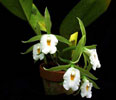|
|
|
|
|
| |
Flasks of
Trichopilia fragrans 'MC1993' × self |
|
| |
|
|
| |
| Number: |
TN3560 |
| Name: |
Trichopilia fragrans 'MC1993' × self
|
| Type: |
self (What's that?) |
|
Seed Donor: |
Dale Borders
|
|
Click to Enlarge

Pod Parent Flower |
Click to Enlarge

Pod Parent Inflorescence |
|
|
|
| |
Culture Notes from Donor: Parent plant: Temperature range CI (58-75°F)
Comments: Parent plant: Flowers strongly scented of hibiscus.
For additional origin/habitat information supplied courtesy of
Charles and Margaret Baker, see further below, near the bottom of this page.
|
Temperatures we attempt to use in the lab & greenhouse:
| For Species: |
|
Spring, Summer, Autumn: days average 77°F, nights 59°F; best fit is Cool-Intermediate 75-58°F
(Source:
Baker's Web OSC) |
| For Species: |
|
Winter: days average 74°F, nights 56°F; best fit is Cool-Intermediate 75-58°F
(Source:
Baker's Web OSC) |
|
About the name...
| Etymology of |
fragrans |
|
From Latin "fragrans" smelling agreeably.
(Source:
Brown 1956) |
| Etymology of |
Trichopilia |
|
From latinized Greek "trichos" hair; "pilios" felt hat. Refers to the hairy column.
(Source:
Mayr & Schmucker 1998) |
| Pronunciation of |
fragrans |
|
FRA-granz
(Source:
Hawkes 1978) |
| Pronunciation of |
Trichopilia |
|
try-koe-PIL-ee-ah
(Source:
Hawkes 1978) |
|
If you would like to direct someone to this web page, please copy and paste this URL into your email:
http://troymeyers.com/d?013560
| Flask Information |
| Availability: |
There were problems with this item and we weren't able to make any viable flasks. |
| You should: |
Consider placing a "Notify Retries" Request, and if an identical pollination (the same parents) is done again, we'll let you know. |
|
You might also want to:
|
View the seed assay for this item.
View items of the same species.
View items of the same genus.
|
|
|
| |
The origin/habitat information below is supplied courtesy of Charles and Margaret Baker
The following information is based on the name of the plant provided by the donor, and assumes that the name is correct. If the plant has been misidentified, then the following information may not be correct.
This text is copyrighted by the Bakers and may not be reproduced without permission.
ORIGIN/HABITAT: Colombia, Ecuador, Peru, Bolivia, Venezuela. In Ecuador,
plants have been collected at numerous locations in the provinces of
Carchi, Imbabura, Loja, Pichincha, and Tungurahua with colletions
especially noted in Pichincha Province between Quito and Santo Domingo.
Plants are found at 3750-7850 ft. (1150-2400 m), but most collections are
made at about 6550 ft. (2000 m). In Peru, plants grow in wet mountain
forests on trees or the forest floor, but Dodson & Bennett (1989)
reported, "Plants growing in deep leaf mold were much more robust than
epiphytic specimens." In the Peruvian habitat, plants are found in the
department of Amazonas at 7850 ft. (2400 m), in the department of Cusco at
6550 ft. (2000 m), in the department of Huánuco at 6050 ft. (1850 m), and
in the department of Junín in the Chanchamayo Valley at 4900-5250 ft.
(1500-1600 m). In Bolivia, plants grow on trees in wet, mountain
cloudforests in the departments of Cochabamba and La Paz, but no
additional information was provided. In Venezuela, plants are found in the
state of Bolívar on the south flank of Auyantepuí at about 3500 ft. (1070
m), near Caracas at 4900 ft. (1500 m), and in the state of Mérida at 4900
ft. (1500 m). In Colombia, plants are found at 5900-8200 ft. (1800-2500
m), but habitat location is not given. Plants are reported to occur in the
West Indies, but we found no records of collection in that region.
More about this information and the Bakers...
|
|
|
| |
|
|
|